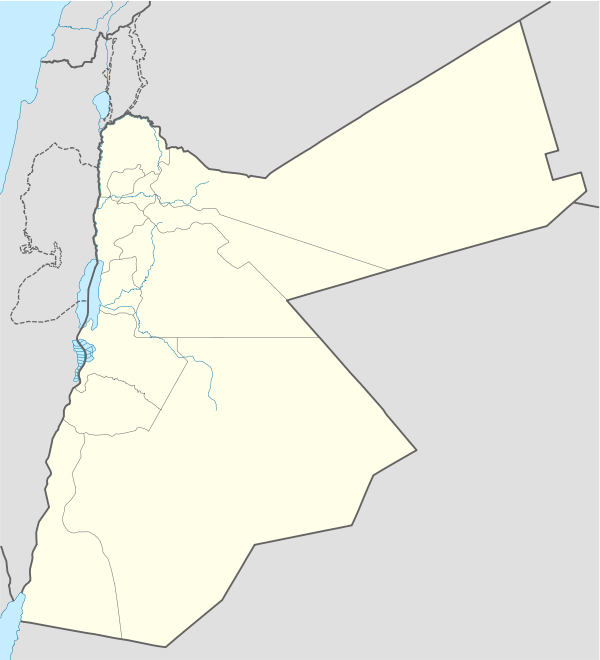Iraq al-Amir
Iraq al-Amir or Araq el-Amir (Arabic:عراق الأمير - literally, "Caves of The Prince"), is the name shared by a town and nearby caves, within the municipality of Amman in the Jordan Valley. Located about 15 km southwest of the town of Wadi as-Seer, it has a population of about 6000 people, mostly members of the tribe of Abbadi. It is located on the hills with high and medium altitude, the area has many springs, and is famous for its olive trees, in addition to other forest trees. About 0.5 km south of the town is located the so-called Al-Iraq historical site, marked by the partially restored palace (known colloquially as Qasr Al-Abd, (literally, "Palace of the Servant") perhaps an ironic reference to the name etched in the caves nearby, believed to be the name of the owner of said estate. There are many caves in the hills which were inhabited during the Copper Age.
`Iraq al Amir | |
|---|---|
 `Iraq al Amir Location in Jordan | |
| Coordinates: 31°55′N 35°45′E | |
| Country | |
| Governorate | Amman Governorate |
| Time zone | UTC + 2 |
Iraq Al-Amir is a stop on the Jordan Trail. It is a side trip of Region 3, Salt to Wadi Zarqa (84.4 km). It is 22.3 km from Salt to Iraq Al Amir or 15.2 km from Fuheis to Iraq Al Amir. From Iraq Al-Amir, the trail makes its way to Husban (19.5 km away).
Qasr Al-Abd
Qasr Al-Abd is one of the most important Hellenistic ruins and remains in Jordan, especially because most of the Hellenistic ruins were built over by Roman buildings, and buildings were continually built upon.
The first known written description of the castle was written by Flavius Josephus, the Romano-Jewish historian. His description goes back to the site's founding. The castle was used in the Byzantine and Classical ages. It was built from white limestone (extracted from the surrounding area) and the dimensions of the rectangular building it was built upon are 18X37.5 meters and its elevation about 14 meters. The walls are estimated between 90 centimeters to 3.90 meters thick. Josephus maintained that it was surrounded by a moat and surrounding walls for protection.
The first floor of the castle has a north and south gate, as well as a north and south corridor. On the west side of both gates, there are four rooms many of which were used for escorting. On the east side there are steps leading to the second floor, . On the north side, water tanks and two lobbies used for storage. On the east side, seven windows for lighting and ventilation.
The second floor has bedrooms and reception rooms. This part of the castle was unfinished, and was partly destroyed by an earthquake in the fourth century B.C.E.
In the summer of 2018, Qasr Al-Abd was renovated by the Jordanian Ministry of Tourism and Antiques. More stone pathways were created around the structure and a building now houses a small theatre that plays an animation, narrated in Arabic and subtitled in French. The animation illustrates what is thought to be the original vision for the dwelling, a summer lodge, surrounded by water, to give the illusion of a boat floating in a sea.
Women's Cooperative
Iraq Al-Amir is home to the Iraq Al-Amir Women’s Cooperative. The Iraq Al-Amir Knowledge Station is located a short distance opposite the parking for the cave parking. It is next to the mosque. The cooperative involves women and girls from nearby Wadi Al Seer villages and produces hand-made paper, ceramics and clay pottery, as well as hand-woven fabrics. The fabric is crafted in a traditional manner, using a hand-weaving mill and three looms.
History of Settlement
The area was first settled in the Middle Stone Age (8000 - 10000) B.C.E. whose settlements in the caves continued until all phases of the Bronze Age, as well as the first and second phases of the Iron Age. Settlement continued throughout the 5th and 4th Centuries B.C.E. under the rule of Alexander the Great of Macedonia. It continued until the year 332 B.C.E., and most flourished into the Hellenistic period. During the Greek Macedonian occupation, Iraq al-Amir was known under the Greek name Tyros. Ptolemy Philadelphus built the city, transferring population from Tyre in Phoenicia. It particularly prospered in the Byzantine period. It was built around the 3rd century BC, and reused under Byzantine rule before being destroyed by an earthquake. Pieces of ceramic/clay were also discovered into the Islamic period, specifically in Umayyad and Mamluk times.
Bibliography
- Will, E. and Larché, F., ‘Iraq al Amir, le Château du Tobiade Hyrcan. 2 vols (Paris: P. Geuthner, 1991) (BAH 132).
- Larché, F., ‘Iraq al-Amir, le Château du Tobiade Hyrcan. Vol. II: Restitution et Reconstruction. 2 vols (Beirut: IFPO, 2005) (BAH 172).
- Rosenberg, Stephen Gabriel, Airaq al-Amir, The Architecture of the Tobiads (Oxford: Hadrian Books, 2006) (BAR International Series 1544).
- Rosenberg, Stephen, "Felicien de Saulcy and the Rediscovery of Tyros in Jordan," Palestine Exploration Quarterly, 138,1 (2006), 35-41.
- 'Iraq al-Amir, guide historique et archéologique du domaine des Tobiades. Beyrouth, Guides archéologiques de l’Ifpo, 2010.